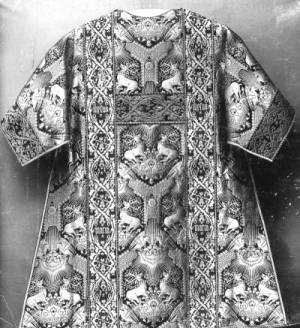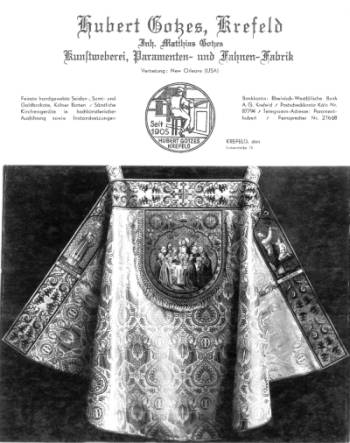

| ANNE WANNER'S Textiles in History / book reviews, articles |
Wenig bekannt, aber hochgeschätzt, by
Karin Thönnissen, in: die Heimat, Krefelder Jahrbuch, No
71, Nov. 2000, p. 75-81; black and white and colour
illustrations, text in german language, |
| In this article in a first chapter, the city of Krefeld is presented, where since the second half of the 17th c. textile industry was established. A short history of the patterns of the vestment's fabrics is following. In the Rhinelands motives like pomegranate and stag were used. New designs in gothic style were executed by Vincenz Statz and Friedrich Stummel. |
|
|
Very important was the medieval exhibition in Crefeld, established by Franz Bock (1823-1899). In a private theater he showed vestments, accessories and vessels. He also published a catalogue. In Bocks mind the medieval ornaments should be used as models and therefore he collected fabrics of this period. The author then names vestment
enterprises in Crefeld: |
pink chasuable from St. Stephan, Krefeld
|
| The collection of Alexander
Schnütgen served Gotzes for models. The painter
Friedrich Stummel supplied him with designs. In 1893
Gotzes received a gold medal at the world exhibition in
Chicago and another in 1900 in Paris. After his death in 1907 at first his widow took over. From 1913-1936 an association of heirs run the business and until the 1970s vestments were produced. |
| Hubert Gotzes,
a distant relative of Theodor Gotzes, first worked as a
silk weaver in Theodors factory. In 1905 he set up for
independence. His 4 sons worked in his factory. In 1916
his son Matthias took the establishment over and when he
died in 1935 his widow run the production. In 1969 she gave the factory to Erwin Maus. But in 1992 when he retired, there was no successor. Thanks to foundations it was possible to save this monument of industry and it became open to the public. |
| home content | Last revised October 26th, 2003 | For further information contact Anne Wanner wanner@datacomm.ch |